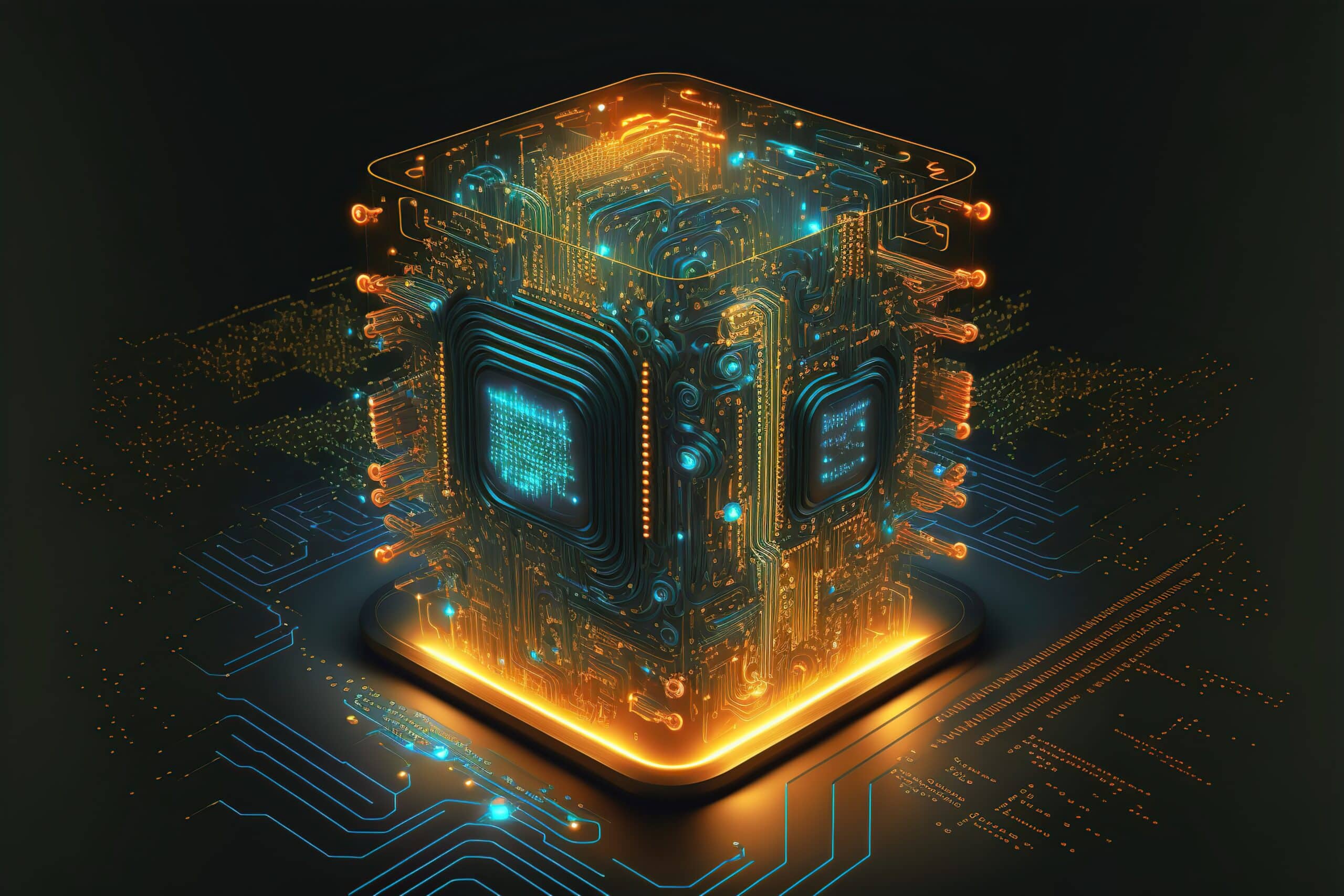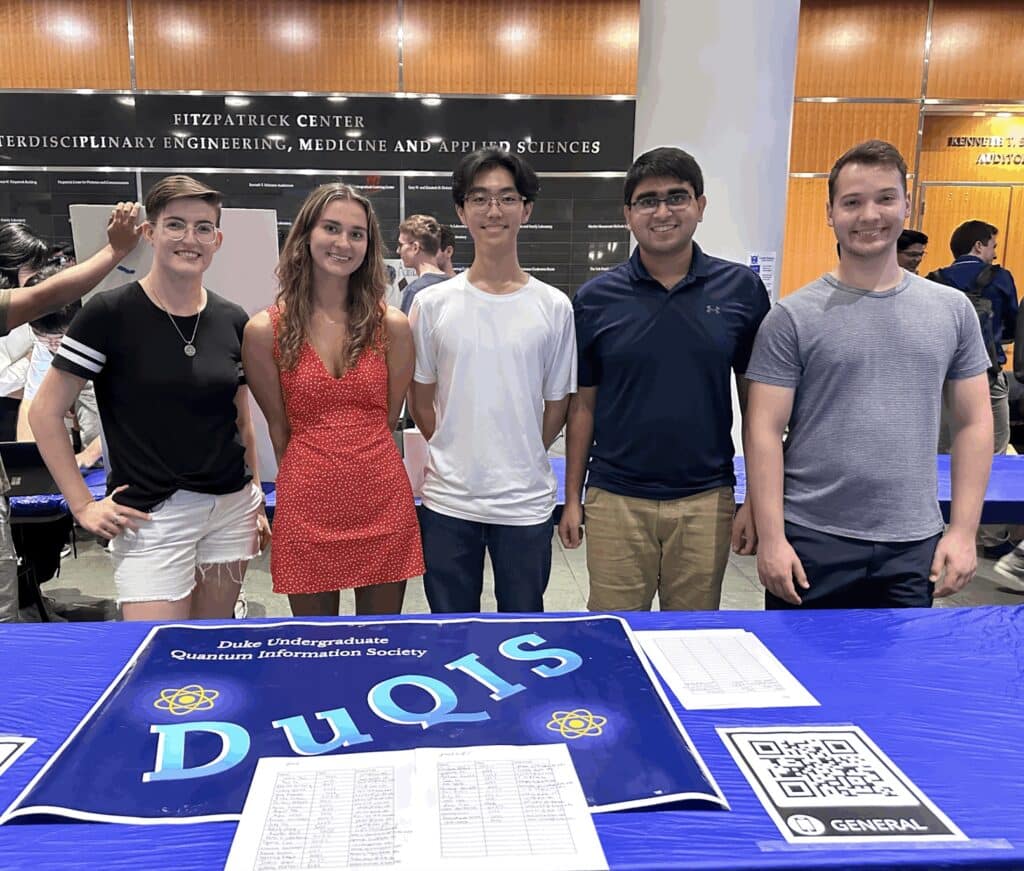Low-key Quantum
By Amrita Ganeriwalla
The university offers an accessible entry into quantum computing through a House Course designed for undergraduate students that is also conducted by the Duke Undergraduate Quantum Information Society (DuQIS)

Quantum computing is an intriguing and intimidating subject. But for students who want to test the waters of the field, Duke offers a fairly accessible route to entry: a house course called Applied Introduction to Quantum Computing.
House courses are taught by undergraduates to small groups of other undergraduates in residential buildings—hence the name. They’re held in the evenings and are sponsored by a faculty member. Since the courses only count for one-half of a credit hour and are scored pass/fail, they’re a good way for students to get a taste of a field or topic before they decide whether or not to take a bigger bite.
In 2021, the Duke Undergraduate Quantum Information Society (DuQIS), started teaching the quantum computing house course. The goal of DuQIS is to connect students who are interested in quantum computing research with different resources. The group advises students, conducts informal advising, brings in speakers from time to time, and builds relationships with different labs at Duke, in addition to offering the house course.
“The Duke University Quantum Information Society is dedicated to promoting curiosity and exploration of quantum computing,” said Sourodeep Bhattacharya, a second-year ECE student who is the club’s president. “Quantum computing is a novel hardware platform that takes advantage of quantum physics to solve many problems that have stumped even the world’s best supercomputers. Through project groups, the Applied Quantum Computing House Course, and speaker panels that feature experts from academia and industry, we hope to share with the Duke community quantum computing’s power to revolutionize cybersecurity, biochemistry, AI, and many other fields.”
“It is an incredibly general overview where we try to build concepts from the ground up, including topics like linear algebra, physics, postulates, super basic principles, and the ABCs of quantum computing.”
Shelby Hartman
Second-year student majoring in ECE and physics
Two members of DuQIS teach the quantum computing house course: Jack Weinberg, a fourth year ECE student, and Shelby Hartman, a second-year student majoring in ECE and physics. The course is sponsored by the Duke Quantum Center’s Kenneth Brown, a professor of electrical and computer engineering whose expertise is in developing fault-tolerant quantum computer systems. Three other members will give lectures over the course of the semester: Bhattacharya and Thomas Kim on quantum computer hardware and Dmitrii Khitrin, a guest lecturer, on quantum information science.
Quantum computing uses the laws of quantum mechanics to solve problems that classical computers find too complex. Even supercomputers—giant classical computers that have thousands of CPU and GPU cores that can run huge calculations— face problems that are sometimes too complex for them to solve. That is where quantum algorithms come in. They create multidimensional computational spaces that are highly efficient. Weinberg says the basic difference between classical and quantum computing is that “quantum computing allows for superposition of states, which are unavailable classically, opening up a whole universe of information processing.”
The house course typically has one section of 15–18 students each semester, mostly first- and second-year students intending to major in some combination of electrical and computer engineering, physics, computer science, and/or mathematics. There are 13–14 lectures each semester, and the course is graded on attendance; there is no final and there are no prerequisites. In lieu of a final, students form groups and can choose either to write a paper on quantum computing or give a presentation to the class, expanding on what was taught in lecture.

The first half of each 75-minute lecture focuses on theory, but the second half practices what was learned in class using Qiskit, IBM’s open-source toolkit for quantum computing, to simulate a small quantum computer.
“It is an incredibly general overview where we try to build concepts from the ground up, including topics like linear algebra, physics, postulates, super basic principles, and the ABCs of quantum computing,” said Hartman in describing the course. There is a primer on linear algebra that students need to understand quantum information, for example, that’s taught at the top of the house course. Quantum information follows, then quantum gates and the algorithms that can be built using these gates. Next, the physical implementations of quantum computers, and then the really interesting stuff, like Bell’s Inequalities.
The instructors point to this as one of the most interesting concepts taught in the course. It deals with the idea of quantum entanglement and how measurements in one qubit affect measurements in another. It shows that certain correlations that aren’t allowed classically can still be observed experimentally. This is strange and counterintuitive and illustrates what makes quantum computing so unlike classical computing.

For students who like the house course and want to learn more, Duke offers multiple courses in quantum computing such as Quantum Information Theory, Quantum Computing and Quantum Error Correction. There are adjacent courses that could be supplemental like Quantum Physics, Representation Theory, Modern Physics, and Quantum Mechanics.
Quantum computing at Duke is not limited to the house course and the club, either; some undergraduates get involved in research, too. Weinberg, for example, works in the lab of Henry Pfister, a professor of electrical and computer engineering and mathematics whose research includes quantum computing, machine learning, and classical information theory.
Hartley works at the Duke Quantum Center, but said that unstructured opportunities to learn abound, too. “IBM has a really fantastic YouTube series where they talk about different algorithms, coding with Qiskit and using their machines,” said Hartman. “Anyone would be able to start learning quantum computing with ease using these tutorials.”
Amrita Ganeriwalla is a first-year Pratt student studying electrical and computer engineering.
